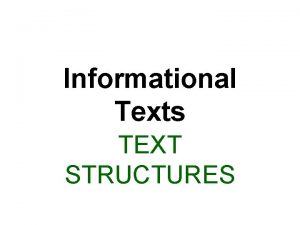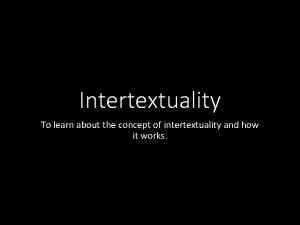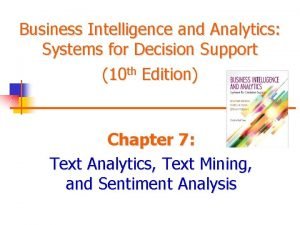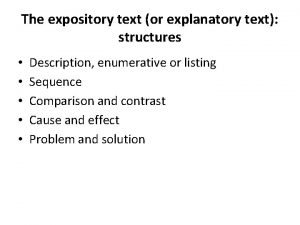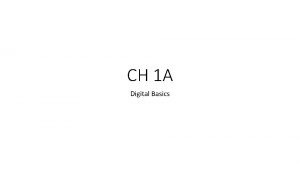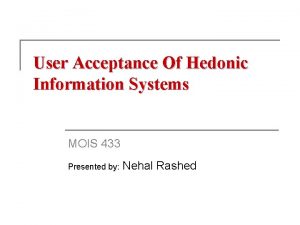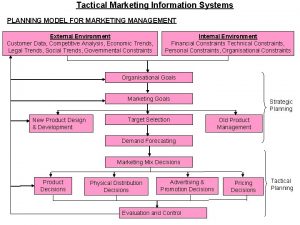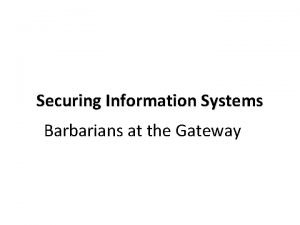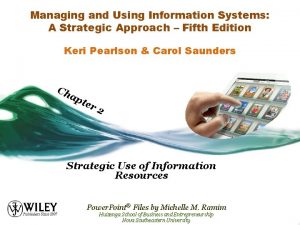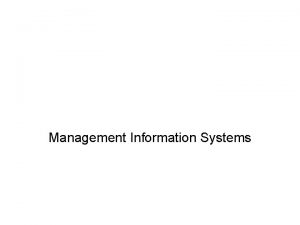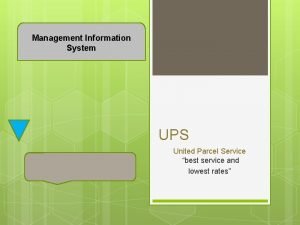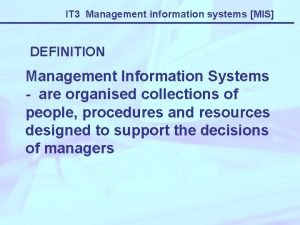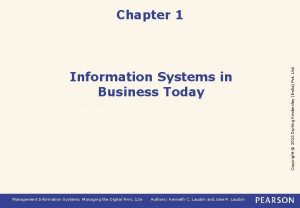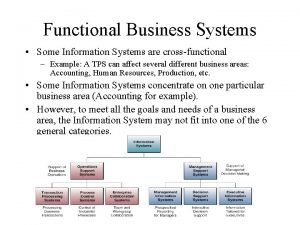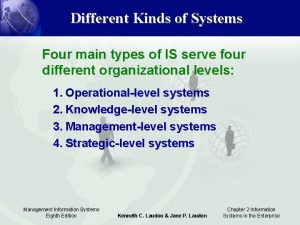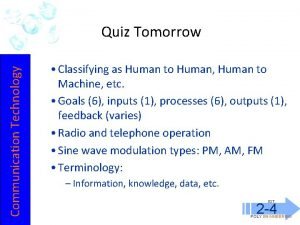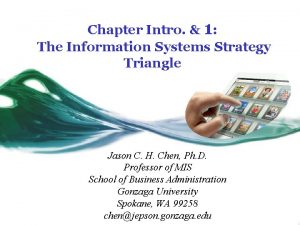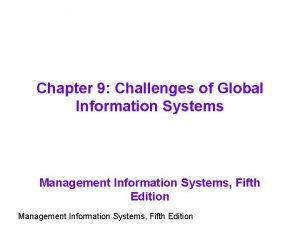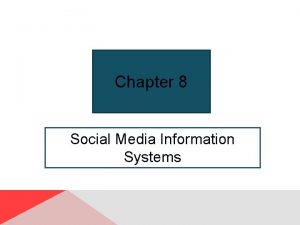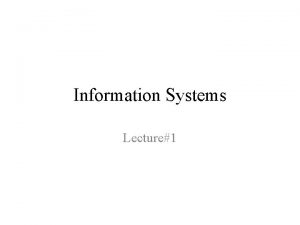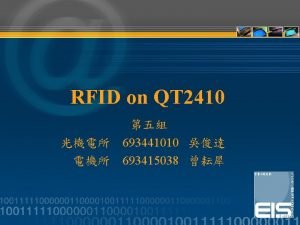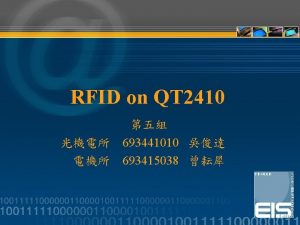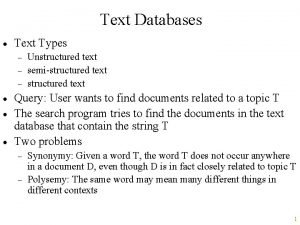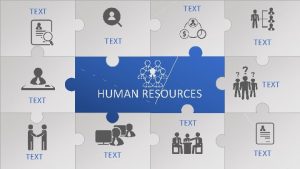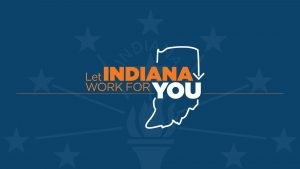Information Systems Lecture14 IT 2410 Information SystemIS Text














































- Slides: 46

Information Systems Lecture#14

IT- 2410 Information System(IS) • Text Book: “Fundamentals of Information Systems by Ralph Stair and George Reynolds, Course Technology; 6 th edition (Januray 1, 2011). ISBN-10: 0840062184.

Introduction to Information Systems Learning Objectives • To explain how IT impacts upon organizations. • To analyze the necessity for IS in the management of modern, and increasingly global, organizations. • To recognize that IT professionals need to understand how an organization operates in order to effectively apply technology to make the organization more efficient and competitive. • To explain how an organization must change in order to successfully capitalize on the use of IS and the consequent impact on organizational structure and employees. • To identify how the benefits of using IS may be measured and assessed, and contrast with existing practice.

What can you get from an Information Systems course? • The value of the information systems professional stems from a breadth of knowledge and skills. “A mile wide and an inch deep” • Requirements of an information system are to do with the people and organizations that the system must serve, as well as IT capabilities. Consequently, the field is a multidisciplinary one, which requires specialist knowledge of the computer world, the world of organizations and people for whom the system must process information, and the professional skills and knowledge to make the former work for the latter. Not least, the information systems professional will have communication and interpersonal skills, for example, needed to elicit those requirements and communicate analyses and designs to decision makers.

Introduction to Information Systems 1. 1 Introduction • Tremendous amount of data provides opportunities to analyze it to make better decisions. • Changing our lives—Communication ways • Information System / Computer Information System • Components of Information System H/W, S/W, People, Procedures, Databases • Quality is in an important issue in business today, the quality of an information system is measured by its ability to provide information.

Organization & Information Requirements No two organizations are similar in all respects. • Size of organization • Its structure • The Culture it follows • Decision Making Structures • Interested parties both internal and external

Why Data and Information ? ? • For example: • Robcor company has two divisions and the two division has 1, 380, 456 and 1, 453, 907 invoices, respectively. • Each invoice has invoice number, date, and amount • The period is from the first quarter of 1997 to first quarter of 2002. • Total 2, 834, 363 records

Why Data and Information ? ?

Why Data and Information ? ? • Data constitute building blocks of information • Information produced by processing data • Information reveals meaning of data • Good, timely, relevant information key to decision making • Good decision making key to organizational survival

Introduction to Information Systems • Data: facts and figures • Information: Processed or meaningful form of data • Knowledge: education and experience create knowledge in humans. • Wisdom: is more difficult to define but represents the ability to learn from experience and adapt to changing conditions.

Characteristics of Information • Timeliness: Information must reach the user in a timely manner, just when it is needed; not too early, because by the time it is used it would be out-of-date; not too late because the user will not be able to incorporate it into his/her decisionmaking. • Appropriateness: Information must be relevant to the person who is using it. It must be within the sphere of his/her activities so that it can be used to reduce uncertainty in his/her decision-making. • Accuracy: Accuracy costs. We don't always need 100% accurate information so long as we know the degree of accuracy it represents (eg: + or - 5%). (Remember the value of information). • Conciseness: Information should always contain the minimum amount of detail that is appropriate for the user. Too much detail causes information overload. • Frequency: Frequency is related to timeliness. Too often the information presented is linked to the calendar (end of the week, beginning of the month); its frequency should be synchronized with the timing of the decision making of the user.

Characteristics of Information • Understandability: The format and presentation of information are very important. Some people prefer tabular information, whereas others may need it in a graphical form. Also the use of colors enhances the understandability of what is presented. • Relevant: It pertains to the particular problem. What data is relevant depends on the decision-making model used. E. g. university admissions officials may choose to consider the results of some high-school test irrelevant, if they believe that it does not improve the chances of some applicant later becoming a successful student. • Complete: All the relevant parts are included. E. g. marketing data about household incomes may lead to bad decisions, if not accompanied by consumption habits of the target population. • Current: Decisions are often based on the latest information available • Economical: The costs of gathering information should be justified by the overall benefits

Sources of Information • Primary: Primary sources are original materials on which other research based. They present information in its original form neither interpreted nor condensed nor evaluated by other writers. • Secondary: interpreted or condensed or evaluated by other writers. • Tertiary: materials in which the information from secondary sources has been digested reformatted and condensed, to put into a convenient, easy to read form.

What is a System • A system is a group of interrelated components working together toward a common goal by accepting inputs and producing outputs in an organized transformation process. System will have the following basic interacting components (functions): 1. 2. 3. 4. 5. Input Processing Output Feedback Control

What is a System The three activities in an information system INPUT PROCESS OUTPUT FEEDBACK (Feedback enables modification of input stage)

What is an information System? • “Information Systems is historically defined as a 'bridge' between the business world and computer science” (Wikipedia) • “Information system is an integrated set of components for collecting, storing, processing, and communicating Information” (Encyclopedia Britannica) • “Information system can be defined technically as a set of interrelated components that collect(or retrieve), process, store, and distribute information to support decision making, coordination, and control in organization”. (Text Book)

Business firms, other organizations, and individuals in contemporary society rely on information systems to manage their operations, compete in the marketplace, supply services, and augment personal lives. Case Studies: page no 37, 43, 54


Why Information System? • Transforming Business • Digital Firm • • • Operational Excellence Customer and Supplier Intimacy New Product/Service/Business Model Improved Decision Making Competitive Advantages Survival

The Emerging Digital Firm • A digital firm is one in which nearly all of the organization’s significant relationship with customers, suppliers and employees are digitally enabled and mediated core business processes are accomplished through digital networks spanning the entire organization or linking multiple organization. • Time shifting 24 * 7 • Space shifting work place wherever

Business Processes • Refers to the set of logically related tasks and behaviors that organizations develop over time to produce specific business results and the unique manner in which these activities are organized and coordinated. e. g. • • Developing a new product Generating and fulfilling an order Creating a marketing plan Hiring an employee • Ways an organization accomplished their business processes? ?

Business Processes and Information System • Business processes refer to the manner in which work is organized, coordinated, and focused to produce a valuable product or service. • Business processes also refer to the unique ways in which organizations coordinate work, information, and knowledge, and the ways in which management chooses to coordinate work. • Every business can be seen as a collection of business processes.

Examples of Functional Business Processes To a large extent, the performance of business firm depends on how well its business processes are designed and coordinated.

Fulfilling a customer order involves a complex set of steps that requires the close coordination of the sales, accounting, and manufacturing functions. FIGURE 2 -1 THE ORDER FULFILLMENT PROCESS

Information systems enhance business processes in primarily two ways: • Increasing the efficiency of existing processes: Information System automate many steps in business processes that were formerly performed manually. New Technology can actually change the flow of information Enabling entirely new processes that are capable of transforming the business(New Business Model) Ordering a book online from Amazon. com By analyzing business processes in your firm, you can achieve a very clear understanding of how your business actually works.

Types of Business Information Systems: • A functional perspective: Identifying systems by their major business function • • Sales and Marketing Systems Manufacturing and Production Systems Finance and Accounting Systems Human Resources Systems • A constituency perspective: Identifying systems in terms of the major organizational groups that they serve • • Transactional Processing Systems (TPS) Management Information Systems (MIS) Decision Support Systems (DSS) Executive Support Systems (ESS) • Systems that span the Enterprise: • Enterprise Systems, Supply Chain Management(SCM) Systems, Customer Relationship Management (CRM) Systems, Knowledge Management Systems(KMS), E-Business.

Sales and Marketing Systems • The sales and marketing function is responsible for selling the organization’s products or services. • help the firm with marketing business processes (identifying customers for the firm's products or services, developing products and services to meet their needs, promoting products and services) and sales processes (selling the products and services, taking orders, contacting customers, and providing customer support). • Examples of Sales and marketing Systems

Sales Information System This System captures Sales data at the moment the sale take place to help the business monitor sales transactions and to provide information to help management analyzes sales trends and the effectiveness of marketing campaign.

Manufacturing and Production Systems • The manufacturing and production function is responsible for actually producing the firm’s goods and services. • deal with the planning, development, and maintenance of production facilities, establishment of production goals, the acquisition storage, availability of production materials, labors availability and scheduling of equipments. • Examples of Manufacturing and Production IS

Overview of inventory System This system provides information about the number of items available in inventory to support manufacturing and production activities.

Finance and Accounting Systems • keep track of the firm's financial assets and fund flows. • The finance function is responsible for managing the firm’s financial assets, such as cash, stocks, bonds, and other investments, to maximize the return on these financial assets. • The accounting function is responsible for maintaining and managing the firm’s financial records—receipts, disbursements, depreciation, payroll—to account for the flow of funds in a firm. • Examples of Finance and accounting information systems

An Accounts Receivable System An accounts receivable system tracks and stores important customer data, such as payment history, credit rating, and billing history.

Human Resources Systems • The human resources function is responsible for attracting, developing, and maintaining the firm’s workforce. • Human resources information systems support activities, such as identifying potential employees, maintaining complete records on existing employees, track employee skills, creating programs to develop employees’ talents and skills and support planning for employee compensation and career development. • Examples of HR Information Systems

An Employee Record keeping System This system maintains data on the firm’s employees to support the human resources function.

Systems from a Constituency Perspective

Transaction Processing Systems • A transaction processing system is a computerized system that performs and records the daily routine transactions necessary to conduct business. • Examples are sales order entry, purchase order entry, hotel reservations, payroll, employee record keeping, cash withdraw, cash deposit and shipping. • TPS are also major producers of information for the other types of systems.

Management Information Systems (MIS) • MIS serve the management level of the organization, providing managers with reports and often online access to the organization’s current performance and historical records. • Typically, MIS are oriented almost exclusively to internal, not environmental or external, events. • MIS primarily serve the functions of planning, controlling, and decision making at the management level • MIS summarizes and report on the company’s basic operations using data supplied by TPS. • The basic transaction data from TPS are compressed and usually presented in reports that are produced on a regular schedule.

Management Information Systems How management information systems obtain their data from the organization’s TPS

A Sample MIS Sale Report MIS usually serve managers primarily interested in weekly, monthly, and yearly results, although some MIS enable managers to drill down to see daily or hourly data if required

Decision Support System • An integrated man-machine system for providing information to support the operations, management and decision making functions in an organization Examples: • Measure customer reactions to re-pricing • Deciding about discount percentages • When to order new stock for the season

Types of DSS consists of • Model Driven DSS • Data Driven DSS

Model driven DSS uses following techniques 1. What-If analysis Attempt to check the impact of a change in the assumptions (input data) on the proposed solution. Examples: • What will happen to the market share if the advertising budget increases by 5 % or 10%?

Goal Seek Analysis Attempt to find the value of the inputs necessary to achieve a desired level of output. It uses “backward” solution approach • Example: a DSS solution yielded a profit of $2. What will be the necessary sales volume to generate a profit of $2. 2?

Executive Support Systems (ESS) • This Computer Based Information System (CBIS) is used by senior managers for strategic decision making. The decisions at this level are non-routine and require judgment and evaluation. They draw summarized information from internal MIS and Decision Support Systems. These systems deal with external influences on an organization as well.

Intelligent Systems • Intelligent Systems Knowledge systems are also called intelligent systems. The reason is that once knowledge system is up and running, it can also enable non experts to perform tasks previously done by experts. This amounts to automation of decision making process i. e. system runs independently of the person making decisions.

Expert System • An expert system is a computer program that attempts to represent the knowledge of human experts in the form of Heuristics. Examples: Medical diagnosis Contract bidding
 Making connections
Making connections Decision support systems and intelligent systems
Decision support systems and intelligent systems Principles of complex systems for systems engineering
Principles of complex systems for systems engineering Embedded systems vs cyber physical systems
Embedded systems vs cyber physical systems Elegant systems
Elegant systems What is a text feature example
What is a text feature example 2 texte nonliterare
2 texte nonliterare Text structures vs text features
Text structures vs text features A report text
A report text Surface connection and deep connection
Surface connection and deep connection Text _____ in a nonfiction text is its organization.
Text _____ in a nonfiction text is its organization. Endtext
Endtext The shaping of a texts meaning by another text
The shaping of a texts meaning by another text Annotation symbols for close reading
Annotation symbols for close reading Language translation
Language translation Narrative vs expository writing
Narrative vs expository writing Linear text to nonlinear text
Linear text to nonlinear text Text analytics and text mining
Text analytics and text mining What is the expository text
What is the expository text Text analytics and text mining
Text analytics and text mining Types of non linear text
Types of non linear text Enumerative text structure
Enumerative text structure What text features are included in this text
What text features are included in this text Plain, unformatted text is sometimes called ascii text.
Plain, unformatted text is sometimes called ascii text. User acceptance of hedonic information systems
User acceptance of hedonic information systems Tactical marketing information system
Tactical marketing information system Securing information system
Securing information system What is retail management information system
What is retail management information system Principles of information systems, seventh edition
Principles of information systems, seventh edition Managing and using information systems
Managing and using information systems Management information system topics
Management information system topics Management information system chapter 1
Management information system chapter 1 Information systems examples
Information systems examples What technologies are used by ups
What technologies are used by ups Definition management information system
Definition management information system Survival in information system
Survival in information system Introduction to information systems 6th edition
Introduction to information systems 6th edition Fundamentals of information systems 9th edition
Fundamentals of information systems 9th edition Fundamentals of information systems 9th edition
Fundamentals of information systems 9th edition Functional information system example
Functional information system example Social and ethical issues in information systems
Social and ethical issues in information systems Types of information systems
Types of information systems Communication technology quiz
Communication technology quiz Administrative information system in healthcare
Administrative information system in healthcare Information system triangle
Information system triangle Global information system
Global information system Social media information systems
Social media information systems










